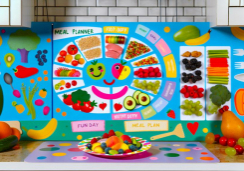8 Best Meal Planning Strategies for Diabetics
You might find it surprising that not all 'sugar-free' products are beneficial for managing diabetes, as they can still affect your blood glucose levels.
As you navigate the complexities of meal planning with diabetes, it's crucial to arm yourself with strategies that go beyond the simplistic advice of avoiding sugars. Understanding the nuances of the Diabetes Plate Method or the impact of the glycemic index on your body requires more than just a cursory glance at nutrition labels.
The best meal planning strategies for diabetics are those that balance enjoyment with regulation, ensuring that your meals are as satisfying as they are healthy. Let's explore how you can transform your daily eating habits with these top strategies, which might just change the way you think about your next meal.
Assessing Carbohydrate Intake
Carefully measuring your carbohydrate portions is crucial in maintaining stable blood glucose levels as a diabetic. To effectively manage blood sugar, you need to be mindful of both the quality and quantity of carbs you consume. Choose whole grains, fruits, and vegetables over refined sugars and processed foods, as they've a less immediate impact on blood glucose levels and provide more nutritional benefit.
Incorporating the Plate Method into your Diabetes Meal Plan is a practical approach. This method suggests filling half of your plate with non-starchy vegetables, one quarter with lean protein, and the remaining quarter with carbohydrate-rich foods. This visual guide helps you maintain a balanced diet without having to count carbs meticulously.
However, it's essential to keep track of your carbohydrate intake throughout the day to ensure a consistent supply of energy and to prevent blood sugar spikes. A registered dietitian can help you personalize your Diabetes Diet, taking into account your unique health needs and medication regimen.
Experiment with different sources of carbohydrates to find what works best for you. Remember, managing diabetes is a personal journey, and what works for one person mightn't work for another. Stay flexible and open to adjustments in your meal plan.
Incorporating the Plate Method
You've learned about tracking carbohydrates, and now it's time to put that knowledge into practice with the Plate Method.
This approach helps you balance macronutrients effectively by visually dividing your plate into sections for non-starchy vegetables, proteins, and carbohydrates.
Mastering portion control techniques through this method can simplify your meal planning and aid in maintaining stable blood sugar levels.
Understanding the Plate Method
To effectively manage your blood glucose levels, consider adopting the Plate Method, a straightforward approach to creating balanced meals with just the right mix of vegetables, proteins, and carbohydrates.
Endorsed by the American Diabetes Association, this method simplifies meal planning without the need for counting, calculating, weighing, or measuring your food.
Balancing Macronutrients Effectively
When incorporating the Plate Method into your meal planning, it's crucial to balance your macronutrients effectively to maintain stable blood glucose levels.
For managing type 2 diabetes, this means filling half your plate with non-starchy vegetables, rich in fiber, which can slow the absorption of sugar into your bloodstream.
A quarter of your plate should be dedicated to lean protein sources like chicken, fish, or beans, which don't spike blood sugar and can help you feel full.
The remaining quarter is for whole grains or starchy vegetables, providing essential energy while keeping blood sugar levels in check.
Opt for low-fat dairy options, and be mindful of saturated fats to support your overall health.
This practical approach simplifies meal planning while ensuring nutritional balance.
Portion Control Techniques
Having balanced your macronutrients using the Plate Method, let's now focus on portion control techniques to fine-tune your meal planning for optimal blood sugar management.
This straightforward approach eliminates the need for counting or measuring, simplifying how you manage your diabetes. On your plate, allocate half for non-starchy vegetables, which are low in carbohydrates and high in fiber, aiding in blood sugar stability.
A quarter should be lean protein, supporting satiety without significantly impacting blood sugar levels. The remaining quarter is for whole grains or starchy foods, providing necessary carbohydrates in moderation.
Remember, consulting with a registered dietitian can personalize your Diabetes Food Plan, ensuring your portions align with your health goals.
Also, choose water, coffee, or unsweetened tea over sugary drinks to complement your meals and support blood sugar control.
Scheduling Consistent Meal Times
Establishing regular meal times is key to managing your diabetes effectively, as it helps keep your blood sugar levels steady throughout the day.
You'll find that planning your meals in advance not only prevents the temptation to skip meals but also positions you to make healthier food choices.
This routine can significantly enhance your blood glucose control and overall health.
Importance of Routine
To effectively manage blood glucose levels, it's crucial to eat meals at consistent times daily. Establishing a routine helps prevent the peaks and valleys that can occur in your blood sugar when meals are skipped or delayed.
Your diabetes food plan should include the plate method recommended by dietitians: load half your plate with vegetables, a quarter with lean protein, and the remaining quarter with whole grains or starchy foods. Don't forget to add small portions of fruits and low-fat dairy, like plain Greek yogurt, to your meal plans. This approach not only supports blood sugar control but can also contribute to weight loss.
Opt for water, coffee, or tea without added sugar rather than sugary drinks, which can spike your blood sugar levels.
Blood Sugar Stabilization
While setting a routine is the foundation for managing diabetes, scheduling consistent meal times builds upon that structure by further stabilizing your blood glucose levels throughout the day. Regular meal times prevent overeating and unhealthy food choices, which are crucial for blood sugar stabilization. By following meal plans made with diabetes in mind, you'll find it easier to improve blood sugar control.
In your plan for diabetes, use the plate method to help keep your blood sugar balanced: fill half your plate with vegetables, a quarter with lean protein, and the remaining quarter with whole grains containing carbohydrates. Don't forget to include small portions of fruits and low-fat dairy. Choose water or unsweetened tea over sugary drinks to effectively manage your sugar intake and support blood sugar stability.
Planning Ahead Benefits
By scheduling your meals at regular intervals, you're taking a proactive step towards maintaining stable blood glucose levels, which is essential for effective diabetes management.
This routine prevents you from skipping meals, which can lead to overeating and making less healthy food choices later.
A Meal Plan for Weight that's designed to improve blood sugar levels should include the plate method, balancing vegetables, lean protein, and whole grains, as recommended by a registered dietitian.
Including small portions of fruits and low-fat dairy ensures your diet plan is comprehensive, supporting not just diabetes control but also potentially safeguarding against kidney disease.
Opting for water, coffee, or unsweetened tea over sugary beverages is another beneficial habit that complements your meal planning efforts.
Choosing Low Glycemic Index Foods
Selecting foods with a low glycemic index, such as non-starchy vegetables and whole grains, can significantly aid in maintaining stable blood sugar levels for diabetics. These foods release glucose more slowly into the bloodstream, preventing sudden spikes in your blood sugar.
Here are three practical ways to incorporate low glycemic index foods into your meals:
- Opt for Whole Grains: Swap out white bread and pasta for their whole-grain counterparts like whole-wheat bread and brown rice. Quinoa and barley are also excellent choices that help keep your blood sugar levels in check.
- Include Lean Protein and Healthy Fats: Add lean proteins such as chicken breast or fish to your meals, and don't forget about the healthy fats found in nuts and seeds. Pairing these with plain Greek yogurt for breakfast or snacks can provide added benefits.
- Choose Low GI Sweeteners: When you need to sweeten your food, pick sweeteners with a low glycemic index, such as stevia or erythritol, to satisfy your sweet tooth without disrupting your blood sugar balance.
It's always a good idea to consult with a registered dietitian to tailor these suggestions to your individual needs. They can provide personalized advice to help you manage diabetes effectively through diet.
Balancing Macronutrients
Understanding how to balance macronutrients in your meals is crucial for managing diabetes, as it helps maintain steady blood sugar levels throughout the day. Carbohydrates, proteins, and healthy fats are the pillars of a well-structured diabetic meal plan.
By including a variety of nutrient-dense foods, you can achieve a balanced intake that supports your blood sugar control. For carbohydrates, opt for whole grains over refined ones, as they've less impact on your blood sugar. Lean proteins, such as chicken or fish, help you feel full longer and have minimal effect on blood sugar levels. Don't forget about healthy fats like those found in olive oil and avocados, which can help slow down the absorption of carbohydrates.
Portion control is another key component. Learn how much of each macronutrient you need, which can be tailored to your individual needs by consulting with a registered dietitian. For instance, Greek yogurt can be a great addition to your meal plan, offering both protein and a creamy texture to keep meals interesting.
Prioritizing Fiber-Rich Options
Incorporating fiber-rich foods into your diet is a smart move for managing diabetes, as they can help regulate blood sugar levels and keep you feeling full longer. Fiber, a vital component recommended by dietitians and food science experts, slows the absorption of sugar, aiding in blood sugar control.
Here's how you can prioritize high-fiber options:
- Choose Whole Grains: Swap out white bread and pasta for whole grains such as quinoa, whole-wheat bread, and oatmeal. These not only provide necessary fiber but also essential nutrients.
- Incorporate Fruits and Vegetables: Aim for a colorful plate with a variety of fruits and vegetables. They're not just rich in fiber; they're also packed with vitamins and antioxidants.
- Include Beans and Lentils: Add beans, lentils, and other legumes to your meals. They're fiber powerhouses that can be easily incorporated into salads, soups, and casseroles.
Planning for Portion Control
Mastering portion control is a crucial skill for diabetics to manage blood sugar levels and maintain a healthy diet. The plate method is a simple, effective way to ensure your meals are well portioned without the need for counting, calculating, weighing, or measuring.
To apply this method, visualize your plate divided into sections: fill half with non-starchy vegetables, a quarter with lean protein, and the remaining quarter with whole grains or starchy foods.
Incorporating small portions of fruits and low-fat dairy, like plain Greek yogurt, into your meal plan helps maintain balanced portions. These foods contribute to your overall nutrient intake without significantly spiking your blood sugar. A dietitian can provide personalized advice on serving sizes that are right for you, taking into account your weight management goals and dietary needs.
To manage portion sizes and blood glucose levels effectively, use a 9-inch plate. This size is ideal for helping you control portions while ensuring you have enough room for a variety of foods.
Utilizing Diabetes-Friendly Recipes
Exploring diabetes-friendly recipes can significantly simplify your meal planning process, ensuring that each dish contributes to stable blood sugar levels and overall health. When you're managing your diet as part of your diabetes care, incorporating foods that help maintain blood sugar balance is crucial. Here are some practical ways to enrich your meals:
- Adopt the Diabetes Plate Method: This simple tool helps you create well-balanced meals with appropriate portions of non-starchy vegetables, lean protein, and whole grains without fussing over complex calculations.
- Embrace Low-Carb Meal Ideas: Reducing your carbohydrate intake can have a positive impact on blood sugar management. Seek out recipes that are rich in nutrients yet low in carbs, and learn to read food labels to make informed choices about the foods you eat.
- Consult a Dietitian: A dietitian can provide you with personalized diabetes-friendly recipes tailored to your preferences. They can also guide you on how to effectively combine these meals with physical activity for optimal diabetes control.
Frequently Asked Questions
What Is the Most Popular Meal Planning Approach Used by Diabetics?
You'll find the Plate Method most popular, focusing on nutritional balance without the fuss of carbohydrate counting. It's practical, promotes consistent carbs, and aligns with the glycemic index for flexible insulin management.
What Is the Best Food Chart for a Diabetic Patient?
You'll benefit from a food chart that emphasizes glycemic index, carb counting, and portion control. Focusing on balanced meals, nutrient timing, and whole foods can stabilize your blood sugar effectively.
What Are the Major Dietary Strategies Used for Diabetes?
You'll manage diabetes effectively with carbohydrate counting, understanding the glycemic index, nutrient timing, and portion control. Regular blood sugar monitoring, choosing healthy fats, and smart snack management are also crucial strategies.
What Is the Best Way to Cook Food for Diabetics?
You'll find grilling, steaming, and sous vide lock in flavors without added fats. Spice wisely to enhance taste. Opt for low-temperature baking and healthy sautéing, and always practice portion control for balance.
Conclusion
Now that you're equipped with these top meal planning strategies, you're set to take control of your diabetes. Remember, balance is key.
Use the plate method, choose low-glycemic foods, and keep those carbs in check. Consistency with meal times and portions supports stable blood sugar levels.
And don't forget, fiber and protein are your allies. With these tactics, and a stash of diabetes-friendly recipes, you'll manage your health deliciously.
You've got this!










